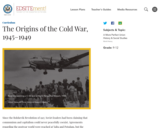
Contains the actual text of all fourteen articles of the North Atlantic Treaty.
- Subject:
- Social Studies
- Material Type:
- Primary Source
- Provider:
- Yale University
- Provider Set:
- The Avalon Project
- Date Added:
- 08/07/2023

Contains the actual text of all fourteen articles of the North Atlantic Treaty.

Since the Bolshevik Revolution of 1917, Soviet leaders had been claiming that communism and capitalism could never peacefully coexist. Agreements regarding the postwar world were reached at Yalta and Potsdam, but the Soviets wasted no time in violating them. Harry Truman believed that the proper means of responding to an international bully was a credible threat of force.

This essay about Roosevelt begins with several quotes describing him. It looks at FDR's personal characteristics and gives some background on his presidency.

View videos, photograph, and renderings of American presidents and their foreign counterparts in this image-rich examination of the post-World War II environment and the cold war that followed it. Includes a review of key foreign-policy decisions of each president and opportunities for you to think through the decisions for yourself.

Part two of a classic "Science in Action" episode featuring Brigadier General James W. Andrew, Air Force general and Dr. Earl S. Herald. [11:24]

This ibiblio.org exhibit discusses in detail the history of the Soviet Union. The site is grouped into two main categories with several sub-headings. One is Internal Workings of the Soviet System including: Repression and Terror: Stalin in Control, Kirov Murder and Purges; Secret Police; The GULAG; Collectivization and Industrialization; Anti-Religious Campaigns; Attacks on Intelligentsia: Early Attacks, Renewed Attacks, Censorship and Suppressing Dissidents; Ukrainian Famine; Deportations; Jewish Antifascist Committee; Chernobyl'; Perestroika. The second main heading is The Soviet Union and the United States including: Early Cooperation, Soviet and American Communist Parties, World War II, and the Cold War.

Geographia presents a brief political and social history of Russia from the beginning of Soviet rule to the resignation of Gorbachev in 1990.

From 1945 to 1991, the United States and the Union of Soviet Socialist Republics (USSR) engaged in the Cold War, a conflict in which the communist Soviet Union and the democratic United States competed for influence over countries around the world. During this era, the US and USSR also took their rivalry beyond earth into space through a series of aeronautic developments and flight tests known as the Space Race. After advances in defense technology during World War II and the United States‰Ûª use of atomic bombs, each side looked to propel its scientific and technological capability forward by building new missiles, rockets, and spacecraft. The Soviets had many early successes in the Space Race, including the launch of the first satellite, Sputnik (1957), and the first man in space, Yuri Gagarin (1961). However, the United States caught up and eventually overtook the Soviet Union, particularly when American astronaut Neil Armstrong and the crew of the Apollo 11 mission became the first humans to land on the moon in 1969.

Gives excellent information on all aspects of the nuclear submarines in use today.

Contains all the text and images of the original document. Also includes a summary of the history behind the signing of this treaty.

A transcript of President Truman's speech delivered before a joint session of Congress outlining the need for financial assistance to Greece and Turkey for US influence in the region.

Collection of primary documents released by Soviet and American governments regarding the downing of an American military spy plane flown by Gary Powers over the USSR.

This resource provides information on the period in Korea just before the Korean War, and on the partition of Korea by the United States and the Soviet Union.

U.S. History is designed to meet the scope and sequence requirements of most introductory courses. The text provides a balanced approach to U.S. history, considering the people, events, and ideas that have shaped the United States from both the top down (politics, economics, diplomacy) and bottom up (eyewitness accounts, lived experience). U.S. History covers key forces that form the American experience, with particular attention to issues of race, class, and gender.Senior Contributing AuthorsP. Scott Corbett, Ventura CollegeVolker Janssen, California State University, FullertonJohn M. Lund, Keene State CollegeTodd Pfannestiel, Clarion UniversityPaul Vickery, Oral Roberts UniversitySylvie Waskiewicz

An overview of the Bay of Pigs Invasion. [13:41]
Khan Academy learning modules include a Community space where users can ask questions and seek help from community members. Educators should consult with their Technology administrators to determine the use of Khan Academy learning modules in their classroom. Please review materials from external sites before sharing with students.

Overview of the Cuban Missile Crisis. [19:00]
Khan Academy learning modules include a Community space where users can ask questions and seek help from community members. Educators should consult with their Technology administrators to determine the use of Khan Academy learning modules in their classroom. Please review materials from external sites before sharing with students.

Learn about the origins and progress of the Korean War. [16:10]
Khan Academy learning modules include a Community space where users can ask questions and seek help from community members. Educators should consult with their Technology administrators to determine the use of Khan Academy learning modules in their classroom. Please review materials from external sites before sharing with students.


The Challenges of Peacetime
The Cold War
The American Dream
Popular Culture and Mass Media
The African American Struggle for Civil Rights

By the end of this section, you will be able to:
Explain how and why the Cold War emerged in the wake of World War II
Describe the steps taken by the U.S. government to oppose Communist expansion in Europe and Asia
Discuss the government’s efforts to root out Communist influences in the United States